October 13-20, 2009
We had an uneventful trip through the C & D Canal. The same overcast, dreary weather stayed with us, but we had low enough winds not to have conditions made even worse (that would come later).
One odd happening occurred after we had exited the canal. The Aberdeen Proving Ground lies just north of the west end of the canal. I've written before about going by there and seeing explosions of varying sorts in the distance, on land and in the water. This time we could hear the explosions and then really feel the shock waves hit FLUKE; it was like a big dull thud on the boat or like someone pounded on the hull. One time we heard a huge explosion, didn't think anything unusual about it until a big wake wave rolled by us. There wasn't another boat anywhere we could see, so we assumed we got hit by a shock wave from one of the underwater detonations.
Our first anchorage was up the Magothy River, in a cove area known as Broad Creek. To reach the entrance to the river you have to go by Baltimore Light. Compared to some of those beautiful lighthouses we saw on the Hudson River, Baltimore Light is not too glamorous, but it is unique in its own way. However, of its type, it is one of the better preserved ones on Chesapeake Bay and it marks not only the river, but the big ship's channel going up towards Baltimore, where it has guided ships since 1908.
There were originally 74 lights on Chesapeake Bay, 30 of them still stand and 23 are still actively used as aids to navigation. Several of them look similar to Baltimore Light (but are mostly ratty looking), the last one constructed, but do not have its same history or exact construction features.
The three story octagonal brick cottage that you can see is constructed atop a 103' tall concrete and stone filled cast iron caisson designed to help support and anchor the structure in the soft mud bottom. The red base and house make up 55' of the visible height above the water. Another 82' of the caisson sits below the water, much like an iceberg.
In 2006 the U.S. Coast Guard held a public auction to sell Baltimore Light. The winning bid was $260,000. Restoration efforts are now conducted by Keepers of Baltimore Harbor Light, L.L.C.
Once we passed the light, getting into the anchoring area was easy. We dropped the hook right off the shore from this architecturally unique glass house. I thought the modern design blended in well with the natural setting, nestled amongst the trees with great views from all the rooms. It was very beautiful lit up at night too, with reflections of golden twinkles in the glass.
The next morning it was cold and drizzling; we had to get an early start, in the dark, to get all the way down to the Potomac River (85 miles) where we planned to anchor for the night before moving on the following day. Eddie got suited up for anchor duty, dressing in his full set of rain gear and boots. Wayne turned on the generator to run the windlass and wash down pump used when pulling up the anchor chain. Since the genset was on anyway, he also turned on the heat to take the chill off the pilothouse and run the 3 fans we had set up to help defog the windows.
Hauling up the anchor went smoothly, and we got underway as Eddie finished up the on deck chores of carefully stowing and tying things down properly. Wayne turned off the generator, like we always do when the deck wash is completed. Eddie came inside and had a temper tantrum when he realized the heat wasn't on any more for him to use to get warmed up with. I felt bad that we hadn't left it on a bit longer, so I told him to get the portable heater from downstairs to bring up to run for a while until he got warmed up. He didn't want to have to do that, so he went downstairs and brought up his “blankie” to cover up with, right over the top of his salty rain gear. He then pouted the entire rest of the day, only coming out from underneath the blanket to eat lunch.
The sun tried to come out and peek through the thin veil of clouds that persistently hung over the Bay, but didn't stay out long enough to make us feel comfortable. It was just another dreary day. Our spirits were lifted and we had a cheery distraction when we recognized a familiar shape and movement of a vessel approaching us in the distance. I squealed “Hey, look it's us!”. When the boat was only about a hundreds yards away I called out on the radio “That's a great looking Whaleback”. We exchanged pleasantries on the radio as we passed each other. HAPPY OURS was one of the Whalebacks we had tried to purchase before we bought FLUKE.
A barge carrying gravel was traveling on a parallel course and similar speed to us so I could see it for many miles. On other occasions I have seen gulls getting a free ride on barges with gravel piles. It is a mystery to me why they do that. The barge travels much slower than the birds could fly to where they are going. Gulls are not particularly social birds trying to be friendly with each other when they are flocked together. They are not getting anything to eat off the gravel. I've seen them perched on fishing boats before, but that makes sense since they can get scraps of food. I have noticed that a lot of them are preening themselves during the ride, with feathers streaming into the water. Maybe they just think of the gravel pile as a protected spot to take care of personal business and the actual ride is secondary.
By late afternoon the wind had started to get gusty, so we were glad to turn up into the Potomac River and head into Smith Creek to drop the anchor in a nice, protected cove, well out of the wind. A bald eagle swooped down to greet us, and I could see 3 deer and a groundhog in a cleared field area on the shore. My idea of a nice anchorage which I would be longing for the next day.
Our first mistake of the following day was pulling up the anchor and leaving that nice, peaceful anchorage. Winds were out of the NW, coming down the Potomac, 20-25 with gusts up to 30KTS. We figured once we turned south we would only have a northerly component to the wind and we could take it pretty well on the stern. We didn't anticipate what would await us when we entered the area where the waters of the Potomac River intersected Chesapeake Bay. That area was like being in a washing machine. The second mistake was not turning around and going back to where we had been.
We had to go a fair ways out to avoid shallow waters to the south that prevented us from making a favorable turn to starboard to ease our ride. In fact, since we had high winds hitting us at 60 degrees off the port bow we turned more northerly into the waves to reduce the wave angle to 30 degrees even though it meant we had to go a longer distance. Seas were only 3-4' but the wind and chop was so awful it was difficult to get a smooth ride. One wave hit us from the side that threw so much water on the front windows it was green, not just a big splash of stray water and foam. It hit the roof and then rolled all the way down the port side of the pilothouse, emptying itself off the back deck. That was the most water I've ever seen hit the windows, even compared to some bad ocean conditions we've been through. Thankfully there was only one like that.
Visitor was the first one to throw up, on a rug, of course. Eddie knew then he was probably doomed to be next since the cat is usually a good indicator of what Eddie can take. While I was downstairs cleaning that up, Wayne's closet flew open, and a plastic storage container filled with a hundred bits of “stuff” spilled out all over the floor in the front cabin. Shortly after that poor Eddie lost the pancakes (and homemade maple syrup purchased from a farmer's market) he had eaten for breakfast over the starboard side. I tried to keep my food in my stomach, thinking of those peaceful critters back at that nice anchorage we had left behind. We all agreed our next order of business was to get off the Bay ASAP.
Fortunately our misery was abated when we could fully make our turn to the south and have the winds and waves off our stern for the most part. By the time we could finally anchor it had been 5 hours since we had left earlier that morning. During the next several days we would wish we had just kept going for the rest of that day.
We sought calm refuge up the Great Wicomico River, west of Sandy Point, nestled safely out of the wind. That is one of the great things about cruising in the Chesapeake; you can find many places to safely anchor in a reasonable amount of time.
Just because we had a nice anchorage it didn't mean that we would be comfortable. With the winds raging out on the Bay, warranting small craft and gale warnings, we couldn't get out of the river. We had to sit idle for 3.5 days: no sun, rain and mist all day and night, and damp cold, never getting above 55 degrees. We would run the generator midday for 1-2 hours to help take the chill off the boat and then again in the evening for 2-3 hours. When the generator wasn't running the warmest the boat would get was about 7 degrees warmer than the outside temperature. Several times we could see our breaths inside the boat. One day when I went to turn on the heater for our midday warming session the thermostat read 52 degrees.
My yachting “outfit” consisted of a heavy pair of pants, turtle neck, sweater, long, lined vest, sweatshirt, wool hat, and shoes and socks to wear inside FLUKE. The guys dressed similarly, and if we were just sitting still we would throw a blanket over our legs. If we had to go outside we would put on a rain jacket. We looked like we should be on a garbage scow huddled around a 55 gallon drum burning debris. At night I even slept with a blanket over my head.
The cold temperature wasn't just a problem by itself. Since the boat isn't insulated and has all the glass windows, condensation was a major issue. Water would accumulate so heavily on the windows, it would run down the glass or drip down from the frames. We had to squeegee a couple of times/day. The wiping towels would never dry no matter where we put them.
Jeff and Karen Siegel, founders of Active Captain, from Castine, Maine pulled into the anchorage the second day and dropped the hook. It was nice seeing their beautiful boat aCapella, a 53' DeFever, and to know our friends were in the same situation (the old misery lovers company philosophy). Neither of us wanted to launch our dinghies, so we promised we would hook up when they were in Vero later this winter. Their blog is at takingpaws.blogspot.com if you are interested.
We finally left the Smith Creek anchorage when the weather forecast dropped the gale warnings and the skies had hopes of clearing when we got underway. Even though 20 KT winds were still forecast, since they were out of the NW and we were going to travel down the west side of the Bay, we thought we could get a decent ride.
When we got out of the river right at sunrise we were so happy to see the sun's rays shining upward from behind a thin bank of clouds on the eastern horizon. We knew that we would finally have a sunny day. We weren't going to complain about the bumpy ride, and despite the cold air temperature, we were able to get some warmth in the pilothouse. No one got sick the whole day, and by the time we made it to Hampton Roads at the south end of the Bay, waters were fairly mild. This car carrier, an odd-looking ship, passed us in the channel. See how the precious freight is all enclosed.
When we made it to the Navy shipyards at the north end of Norfolk, the sun was in the western sky as bright as we had seen it in two weeks. The Navy yards and ships were illuminated the best we had ever seen them (usually we are traveling by them at sunrise and can't see squat).
We had decided to try to make it at least to downtown Norfolk and check out a couple of free tie ups we had read about: High Street and Front Street, on the west side of the river in Portsmouth. There is room for a few boats at each place, and even though signs say “No Overnight Dockage” cruisers have reportedly been staying there with no problems. I hope we do stay there for a day in the future whereby we could catch a ferry across the river and tour some sights in downtown Norfolk. The city looked the prettiest we have ever seen it with the clear skies and bright sunshine.
Both docking areas looked OK, but since we had made good time we thought we could go a bit farther and get ourselves in a position to get a better start the following morning so we could get through the Great Bridge Lock at the 0800 opening. To do that, we ended up tied up at a floating dock belonging to a shipyard almost at the intersection of the ICW and Deep Creek, the waterway to the Dismal Swamp Canal. We had traveled 88 miles that day.
I've written before about the Great Bridge Lock. It's primary function is to keep the fresh water
of the back country of North Carolina from the salt water of coastal Virginia. The 30 locks we had transited in NY were used to move boats through changes in elevation. The weather system we had been experiencing had caused extremely high tides, and the lock was having to be closed a few hours midday during the high tide cycle, wrecking havoc with southbound boating traffic The Coast Guard had been broadcasting that info over the last 3 days, so we were aware of what was going on. I asked a lock attendant why the lock had to close, and he said water was spilling over the top of the gate on the VA end, and they had no where to move the water.
There was plenty of room for us at the Great Bridge free dock since we had gotten there so early and cruisers from the previous night had already left. We had a hot breakfast to thaw out from the 36 degrees it was when we locked through. Then, we had enough time to do some grocery shopping (October special was 5% off the total bill for senior citizens on Tues. & Thurs, so we lucked out!), get some boat chores done, and take a walk to one of our favorite destinations, Dairy Queen. Banana splits were on sale for only $1.99. Eddie wondered if it would be possible to take an extra one back to FLUKE and freeze it. I think it is so weird how we had been freezing to death for days, but we couldn't wait to eat ice cream. However, I wasn't complaining as I sat in the warm sun slopping down my Blizzard.
We also had a great time watching the parade of boats that locked through subsequent to us throughout the day. One opening locked through 21 boats; just listening to the lock attendant giving the captains entry and positioning instructions was entertaining. One of the display plaques at the Great Bridge Lock Park says that the lock can hold as many as 20 boats, so you know it was really packed with 21.
They all have to jockey for position when they come out of the lock into the narrow waterway since the Great Bridge is only ¼ mile away, and the bridge tender starts yelling at them over the radio to hurry safely forward so he doesn't have to keep the bridge open and hold up vehicular traffic any longer than necessary. Once they pass the bridge they have to go by a huge marina, and they get yelled at again for going too fast past the fuel dock and moored boats.
From here forward the weather will dictate the route we take, i.e. whether we will have to travel down the crowded, sometimes shoaled, heavily bridged, ICW or take a short cut with overnight passages in the offshore solitude of the Atlantic Ocean.
Tuesday, October 20, 2009
Subscribe to:
Post Comments (Atom)
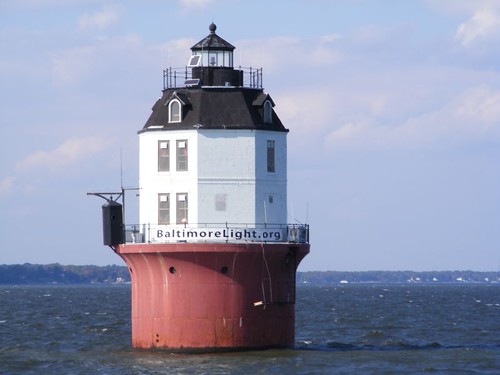

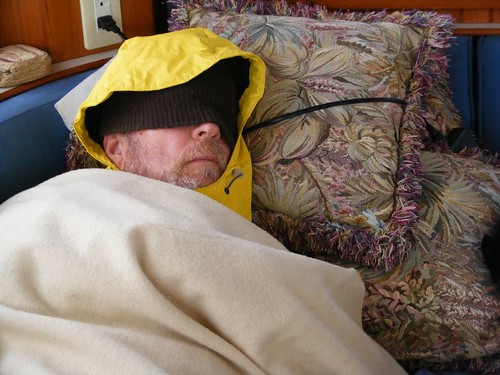
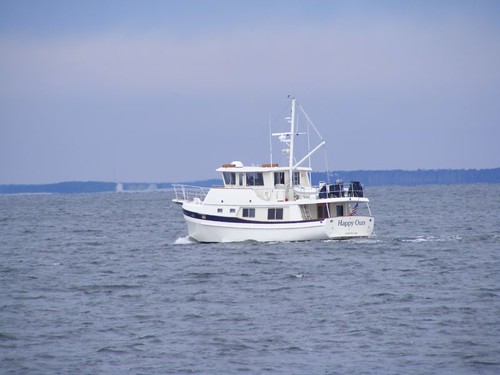

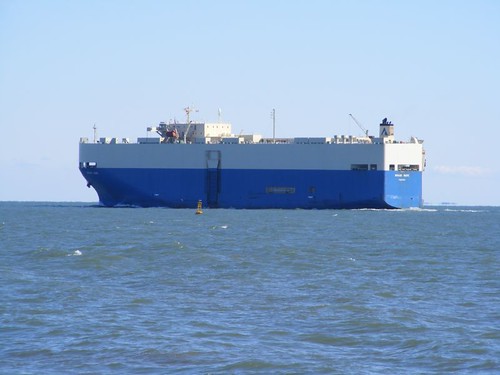
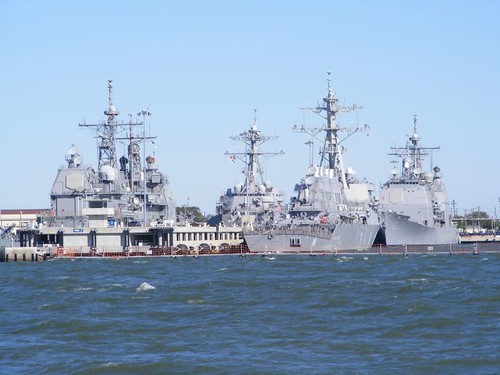
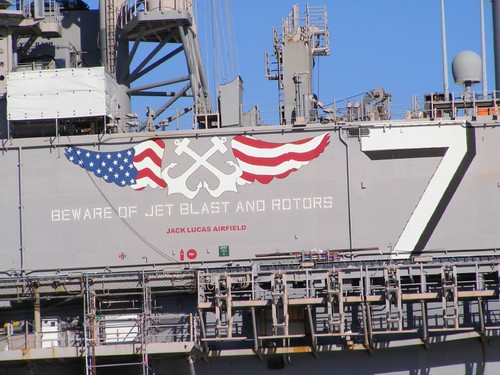

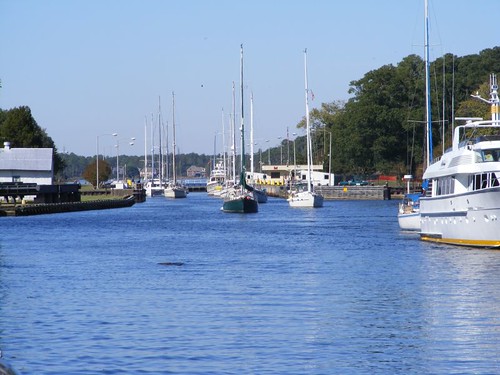








It was great to see you guys although all we could do was watch your boat swinging in the wind!
ReplyDeleteFinally the warmth has returned to all of us.
Have a safe journey.
Jeff & Karen aboard aCappella